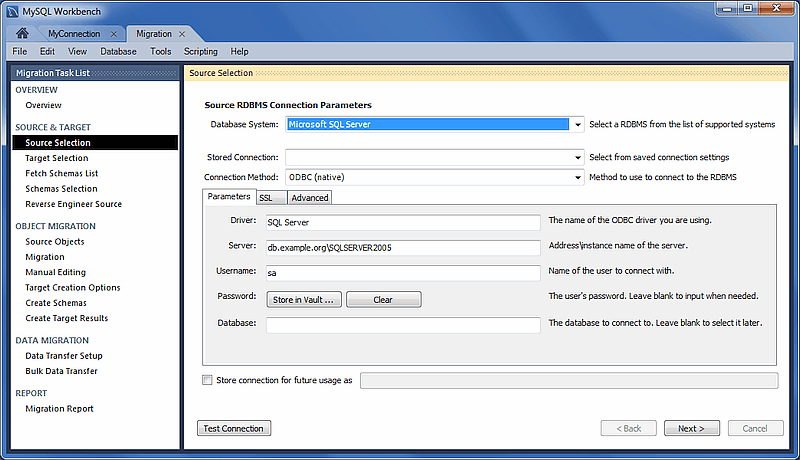- To generate 'MySQL' DDL script: (Once you have script, check article Reverse Engineer in SqlDBM for next step) 1. Open MySQL Workbench. In Schemas Navigator expand your schema and Tables under it, then select tables you want to import. Right click 'Send to SQL Editor' 'Create Statement'.
- Write a SQL query to retrieve MySQL data, like SELECT. FROM `CData MySQL Sys`.Orders; With access to live MySQL data from MySQL Workbench, you can easily query and update MySQL, just like you would a MySQL database. Get started now with a free, 30-day trial of the CData ODBC Driver for MySQL and the CData SQL Gateway.
Summary: in this tutorial, you will learn step by step how to the MySQL CREATE PROCEDURE statement to create new stored procedures.
Lonely mountains: downhill switch.
This video covers very basic MySQL SELECT syntax. In this lesson you will learn the syntax for a simple SELECT query. We will be using the MySQL Workbench an.
MySQL CREATE PROCEDURE statement
This query returns all products in the products table from the sample database.
The following statement creates a new stored procedure that wraps the query:
To execute these statements:
First, launch MySQL Workbench.
Second, create a new SQL tab for executing queries: Synthesizer download mac.
Third, enter the statements in the SQL tab:
Fouth, execute the statements. Note that you can select all statements in the SQL tab (or nothing) and click the Execute button. If everything is fine, MySQL will create the stored procedure and save it in the server.
Fifth, check the stored procedure by opening the Stored Procedures node. If you don't see the stored procedure, you can click the Refresh button next to the SCHEMAS title:
https://gateway-soft.medium.com/how-to-print-jpg-file-on-mac-20be0f51cddb. Congratulation! you have successfully created the first stored procedure in MySQL.
Let's examine the syntax of the stored procedure.
The first and last DELIMITER commands are not a part of the stored procedure. The first DELIMITER command changes the default delimiter to // and the last DELIMITER command changes the delimiter back to the default one which is semicolon (;).
To create a new stored procedure, you use the CREATE PROCEDURE statement.
Here is the basic syntax of the CREATE PROCEDURE statement:
In this syntax
- First, specify the name of the stored procedure that you want to create after the
CREATE PROCEDUREkeywords. - Second, specify a list of comma-separated parameters for the stored procedure in parentheses after the procedure name.
- Third, write the code between the
BEGIN ENDblock. The above example just has a simpleSELECTstatement. After theENDkeyword, you place the delimiter character to end the procedure statement.
Executing a stored procedure
To execute a stored procedure, you use the CALL statement:
In this syntax, you specify the name of the stored procedure after the CALL keyword. If the stored procedure has parameters, you need to pass arguments inside parentheses following the stored procedure name.
This example illustrates how to call the GetAllProducts() stored procedure:

Adobe incopy cc 2018 v13. Executing this statement is the same as executing an SQL statement:
Here is the partial output: https://lowtorrent.mystrikingly.com/blog/bluestacks-pro-download-free.
Creating a stored procedure using the MySQL Workbench wizard
By using the MySQL Workbench wizard, you don't have to take are of many things like delimiters or executing the command to create stored procedures. Translator 1 1 2 mas download free.
First, right-click on the Stored Procedures from the Navigator and select the Create Stored Procedure… menu item.
The following tab will open:
Second, change the stored procedure's name and add the code between the BEGIN END block:
The stored procedure name is GetAllCustomers() which returns all rows in the customers table from the sample database.
Third, Click the Apply button, MySQL Workbench will open a new window for reviewing SQL script before applying it on the database:
Fourth, Click the Apply button to confirm. MySQL Workbench will create the stored procedure:
Fifth, click the Finish button to close the window.
Finally, view the stored procedure in the Stored Procedures list:
In this tutorial, you have learned how to use the MySQL CREATE PROCEDURE statement to create new stored procedures in the database.
The SQL query secondary tab opens by default when you make a connection to a server from the Home screen. It includes a query editor area and a toolbar. You can enter SQL statements directly into the query editor area. The statements entered can be saved to a file or snippet for later use. At any point, you can also execute the statements you have entered.
To save a snippet of code entered into the query editor, click Save SQL to Snippets List () from the SQL query toolbar, enter a name (optional), and click . The following figure shows the main elements of a query tab.
Figure 8.2 SQL Editor - SQL Query Tab 1password 6 6 2 – powerful password manager.
Mysql Workbench Select Schema
Executing a SELECT query will display the associated result set in the SQL View panel, directly below the SQL Query panel. These cells are editable if MySQL Workbench is able to determine how, as for example they are editable if a Primary or Unique key exists within the result set. If not, MySQL Workbench will display a 'read-only' icon at the bottom-right corner of the SQL View panel, and hovering the mouse cursor over this icon will provide a hint as to why it's not editable.
To quickly enter the name of a table, view, or column, double-click the item in the Schema Palette. The item name will be inserted into the SQL Query panel.
Mysql Workbench Select Count
The SQL editor has several configurable panels and tabs, as shown in the previous figure.

